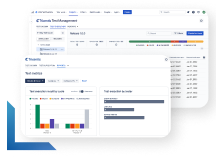
Types of QA testing tools
QA testing tools fall into three general categories:
- Test management tools assist QA teams with writing test cases for software based on project requirements. These tools help teams create, plan, and execute test cases and track bugs against requirements. Test management tools can also automatically capture the results of automated tests.
- Performance testing tools help QA teams evaluate the scalability and reliability of an application. These QA testing tools simulate performance in a distributed environment, testing maximum and minimum response times with different loads.
- Functional testing tools evaluate discrete features or modules of software and report errors to the development or QA team. This category of tools includes tools for API testing, unit testing, multi-browser testing, and multi-device testing.
How to choose automated QA testing tools
There are 10 essential capabilities to keep in mind as you compare QA testing tools.
- Features for specific technical role skills —Ω your QA testing tools must meet the needs of developers and test automation experts
- Suitability for users with nontechnical role skills, including business analysts, subject matter experts, and other non-programmers
- Cross-platform/browser support, enabling your teams to test across operating systems, browser types/versions, and mobile devices
- Change impact analysis – the ability to prioritize tests based on code changes and risk
- Tools with templates and accelerators, including template libraries and wizards, that simplify testing for specific applications such as ServiceNow testing, Salesforce testing, or SAP testing
- Breadth of technology support – consider what kind of QA testing tools you’ll need to support various UI and API formats/protocols across desktop, web, mobile, AR/VR, IoT, and full-stack cloud application testing
- Intelligent automation – QA testing tools that incorporate technologies like AI, machine learning, self-healing technologies, bots, and automated test generation
- Open-source support for, and extension of, open-source testing tools and frameworks
- DevOps tool integrations that offer support for DevOps, Agile planning, and ALM tools
- Dashboards and analytics that track and analyze overall test progress, sprint-level test activities, and individual tests
Best practices for using QA testing tools
Test one aspect of code at a time. Each test should focus on a specific feature or a part of the user experience.
Perform regression tests often. Central features of applications should be tested every time there are new additions to code.
Choose a system for reporting and tracking bugs. Open-source tracking tools provide an inexpensive option, while proprietary tools can be customized to your specific workflow.
Invest in analytics. Track specific QA metrics to determine where bugs are most likely to occur. This will help your teams design tests that address critical areas.
Test multiple environments. Your QA testing tool should enable testing over a broad array of devices, operating systems, and user profiles.
Focus on UI. Functional tests by human testers can deliver a better sense of the quality of an application’s UI.
QA testing tools and Agile development
A growing number of companies have adopted Agile and DevOps methodologies to accelerate software development and speed to market. To integrate testing into this software delivery model, many development and QA teams require new QA testing tools that overcome the limitations of legacy systems. Most legacy tools don’t integrate with open-source test automation solutions, making it impossible to successfully integrate testing into continuous delivery pipelines. Testing inevitably gets pushed to the end of the development sprint when fixing bugs that are embedded in the code becomes more difficult, time-consuming, and costly. QA becomes a bottleneck, software releases are often delayed, and the quality of the product tends to suffer.
To accommodate testing in an Agile or DevOps environment, companies need QA testing tools that are:
- Versatile. QA testing tools must be easy to use, consistent, and easy to integrate with existing tools across the software delivery pipeline.
- Distributed. The right tools must break down functional silos, allocate workloads across teams, and empower testers to collaborate.
- Scalable. Testing tools must be able to accommodate a quickly expanding test suite, allowing QA teams and processes to keep pace with the speed and complexity of development.
- Analytics-driven. Modern test management tools must have actionable analytics that streamline reporting and produce insights to optimize processes and improve quality over time.
Testing tools from Tricentis
The Tricentis Continuous Testing platform provides a suite of QA testing tools that is totally automated, fully codeless, and intelligently driven by IA. With Tricentis, you can easily integrate testing into Agile and DevOps methodologies to dramatically accelerate software delivery, reduce costs, and improve quality across custom and enterprise apps.
The Tricentis platform of testing solutions supports all phases of testing and includes:
- Intelligent test automation. Tricentis Tosca provides codeless test automation powered by Vision AI to optimize and accelerate end-to-end testing.
- Agile test management. Tricentis qTest offers scalable, in-sprint Agile and Jira test management for automated testing, exploratory testing, and BDD.
- Smart impact analysis. Tricentis LiveCompare provides insight into what to test to de-risk SAP changes.
- Performance testing. Tricentis NeoLoad manages performance testing for enterprise applications.
- Data integrity testing. Tricentis Data Integrity automates end-to-end data integrity testing to prevent costly issues with integration, data migration, and reporting.
- Analytics and reporting. Tricentis Analytics provides real-time unified testing data and insights on your favorite analytics and data warehouse platforms.
- App-native test automation. Tricentis Test Automation for ServiceNow automates testing for ServiceNow applications and workflows that are built on the Now Platform.
